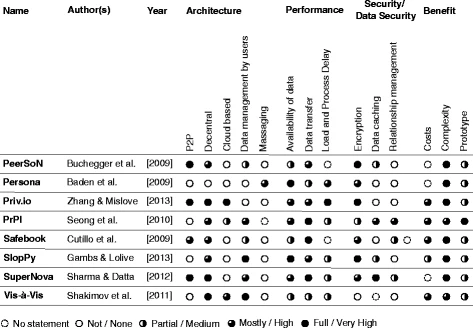Persona Social Networking System
A Persona Social Networking System is a Semi-Decentralized Social Networking System that encrypts user data with an attribute-based encryption.
- AKA: Persona OSN.
- Context:
- It was first developed by (Baden et al., 2009).
- It can include the following DOSN's services:
- Example(s):
- …
- Counter-Example(s):
- See: Decentralized Social Network, Online Social Network, Centralized Social Network, Distributed Network, Decentralized Network, Decentralized Web, Decentralized Computing System, Decentralized Cloud System, Decentralized Clinical Trial.
References
2017
- (Muller et al., 2017) ⇒ Andre Muller, Andre Ludwig, and Bogdan Franczyk (2017). "Data Security In Decentralized Cloud Systems – System Comparison, Requirements Analysis And Organizational Levels". In: SpringerOpen - Journal of Cloud Computing.
- QUOTE: The results of the comparison are summarized in Fig. 1. The solutions of the investigated concepts of PeerSoN (Buchegger et al., 2009), Priv.io (Zhang and Mislove, 2013), Safebook (Cutillo et al., 2011), and SuperNova (Sharma & Datta, 2012) are based on a peer-to-peer approach. The concepts PrPl (Seong et al., 2010), SlopPy (Gambs & Lolive, 2012), and Vis-à-Vis (Shakimov et al., 2011) are based on distributed applications and on server solutions as well as cloud solutions that are self-managed by the user. As a common ground of these concepts, all parties are expected to run and manage their own cloud system. The eight already mentioned systems will now be explained shortly and examined with regard to their currently unsolved problems.

|
2009
- (Baden et al., 2009) ⇒ Randy Baden, Adam Bender, Neil Spring, Bobby Bhattacharjee, and Daniel Starin (2009). "Persona: An Online Social Network with User-defined Privacy". In: Proceedings of the ACM SIGCOMM 2009 Conference on Data Communication ACM (SIGCOMM 09).
- QUOTE: Each Persona user generates an asymmetric key-pair and distributes the public key out-of-band to other users with whom they want to share data. We refer to these other users as friends, though the nature of each relationship is defined by the user.
Persona allows users to create “groups” and choose which users are part of a given group. Users control access to personal data by encrypting to “groups.” Restricting data to specific groups allows users to have fine-grained control over access policy, which permits exchanging data with more restrictions.
Cryptographic primitives in Persona must allow users to flexibly specify and encrypt to groups. Users may specify groups using arbitrary criteria, but we expect users to choose groups based on transparent relationships such as “neighbor” or “co-worker” or on attributes such as “football fan” or “knitting buddy.” Groups created by one user do not affect the groups that can be created by another. However, to support OSN communication patterns, the groups created by one user should be available for use, not just for decryption, but also for encryption, by friends.
- QUOTE: Each Persona user generates an asymmetric key-pair and distributes the public key out-of-band to other users with whom they want to share data. We refer to these other users as friends, though the nature of each relationship is defined by the user.